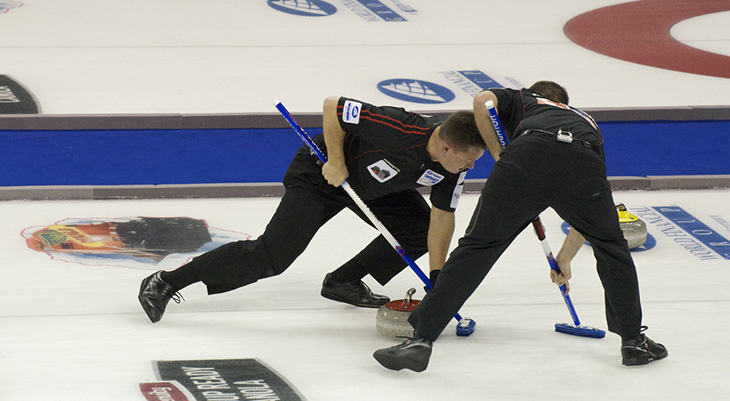New Broom Technology Sweeps Through Curling World

(Inside Science) – Even though the ice is still the same, and most of the 42-pound stones sent down the ice in each contest still come from the Scottish island of Ailsa Craig, there's a technological controversy brewing in the world of curling. Top players are concerned that a new type of broom makes it too easy to control the direction of the sliding rock, and could damage the ice.
After a recent international tournament in Toronto, where players complained about some new brooms and had them removed from play, more than 40 elite teams from around the world signed a pledge not to use brooms with so-called "directional fabric" and asked the sport's governing bodies to rule on whether brooms with that fabric should be allowed.
"Strong sweepers who have put in the effort to get bigger, stronger, faster, biomechanically sound and more athletic should be rewarded, not the team with the best technology," the statement reads.
After a rock is thrown down the sheet, the sweepers might be called on to vigorously rub the ice in its path, to keep it on course and make it travel further.
"Depending on the ice surface, the texture of the rock and the ability of the sweepers, they could get it to go between 4 and 10 feet further," said Gerry Peckham, high performance director at Curling Canada.
Sweeping helps the rock in three ways. It clears small bits of dirt and debris from the path of the rock, scrubs off the frost that forms on the ice surface and melts a small amount of the ice to lubricate the path. All three aspects help reduce friction in the path of the rock, so that it can slide faster, farther and straighter down the ice.
In curling's early days, players used large straw brooms mainly to sweep snow off of outdoor rinks. In the mid-1970s, they began to switch to more effective and efficient hog hair and horse hair brushes, and then to synthetic nylon pads. Those pads have gotten smaller and firmer over the years, and now often have some kind of reflective backing behind them to reflect heat down towards the ice. But none of these advancements caused the kind of uproar that the new "directional fabrics" have in the past few weeks.
"We haven't seen anything in the past 50 years that has set off alarm bells like we've seen recently," said Peckham.
Scott Taylor, president of BalancePlus, a curling equipment supplier, said "directional" fabric is just a slang term developed by players to describe the new brooms – it's not actually different from the normal broom head, except that the nylon cover has been reversed so that the waterproof coating on the back of the fabric is in contact with the ice.
In order to make the front side of a fabric smooth, weavers use different-sized yarns for the horizontal and vertical parts of the weave, which creates little hills and valleys on the reverse side. Once the waterproof coating is applied, that side of the fabric becomes much stiffer than the front. So when it is rubbed along the ice, "it acts more like a file than sandpaper, and cuts microscopic lines into the pebble," the tiny bumps that are part of the surface of ice prepared for curling, said Taylor. That seems to be enough to dramatically alter the behaviour of the rock.
It was prototype brooms made by BalancePlus that were the focus of complaints at the Toronto tournament, but Taylor says they were never intended for sale, and were meant to demonstrate the problems that the reversed fabrics could cause. Players said the brooms allowed sweepers to "steer" the rock much more than they were comfortable with, and even slow them down.
The brooms have been compared to high-tech drivers that allow amateur golfers to hit the ball as far as a pro, or the advanced full-body swimsuits that were banned from competition in 2010 for providing an unfair advantage.
"It's gone too far from what people want from curling," said Taylor. "It's all within the rules, but just doesn't suit the sport."
Curling has no formal rules on what equipment players can use, as long as they are not deliberately damaging the ice. But Peckham said the national and international curling federations are working towards doing some formal testing on new equipment technologies, so that they can rule on whether it should be allowed or not, but they are currently not set up for that kind of work.
"We don't have any laboratories to test new equipment, but we will have to start heading in that direction," he said. "No one foresaw that technology had the ability to affect play this much."

